Django Reinhardt, live in New York.
Our Last Call columnist considers his dream Rig Rundown subject.
“Django was music made into a man.” —Emmanuel Soudieux, Django’s bassist
My friend and colleague Chris Kies recently filmed a Pantera Rig Rundown. One could argue that Pantera is the reason that Rig Rundowns exist. Pantera, more specifically Pantera’s guitarist “Dimebag” Darrell, got Kies into guitar, and he eventually—along with former PG editorial director Joe Coffey—came up with the idea of filming guitarists with their rigs. So you have Hell’s own cowboy, Dimebag, via Kies to thank for the Rundown brand of infotainment.
When the Rundown team got together to yak about Kies’ white-whale interview during a Gig Rundown, I began to wonder what my dream Rig Rundown would be. The choice is easy, though filming it would require a DeLorean, a flux capacitor, and 1.21 gigawatts of power to take us back to 1946 when Django Reinhardt toured the U.S. with Duke Ellington.
Django Reinhardt remains my personal guitar hero. You’ll never hear a player who is more in command of the instrument. Django’s playing was creative and fearless, lighting fast, but never rushed, fiery but relaxed, showy but subtle and sweet. And as brilliant as Django’s playing was, the man was as remarkable as his music. Django seemed to embody everything beautiful and terrible about musicians, incarnating the bad luck, immense talent, shifty business practices, hubris, and laziness. He’d show up for scheduled concerts without a guitar or skip sold-out concerts to take a walk on the beach or whatever he felt inspired to do. Some days he’d refuse to get out of bed at all.
”Django seemed to embody everything beautiful and terrible about musicians, incarnating the bad luck, immense talent, shifty business practices, hubris, and laziness.“
Django Reinhardt was born in a Roma encampment near Belgium in 1910. As a child, the nomadic camp moved outside of Paris, where Django excelled at playing violin, banjo, and guitar, as well as stealing chickens. When he was 18, a fire engulfed his trailer one night, which paralyzed the third and fourth fingers on his left hand. During his 18-month convalescence, Django reinvented his guitar playing. In doing so, he created a new style of music dubbed "gypsy jazz," making him the first great European jazz musician.
During World War II, Nazis exterminated over a million people of Roma heritage and Hitler decreed that listening to jazz could get you sent to a concentration camp. Paradoxically, Django enjoyed the most lucrative period of his career, living and playing openly among Nazi soldiers, who used Paris as a party town during the war.
After the war, while on tour in Zürich, Django lost most of his money gambling in a casino. But in a quick reversal of fortune, he was contacted by a William Morris agent who told him that Duke Ellington would like Django and his musical partner Stéphane Grappelli to join him on tour in the U.S. Django selfishly chose not to tell Grappelli about the tour and went alone.
According to Reinhardt biographer Charles Delaunay, Django was accustomed to his brother Joseph carrying and tuning his guitar, so he arrived in the U.S. without luggage or a guitar. Django believed American companies would be throwing guitars and money at him when he arrived. He was wrong. An agent rounded up a high-action Gibson ES-300 that felt nothing like his sleek, low-action Selmer strung with light ”silk-&-steel” strings (.010–.046). He plugged into an amp he didn’t know how to operate, and oscillated between too loud and inaudible. Accounts say it took him five minutes to tune his guitar. At their Carnegie Hall concert, according to Delaunay, Django ran into boxer Marcel Cerdan on the street, and the two headed to a cafe. Consequently, the guitarist was two hours late. Django went back to Paris not long after the ill-fated show because, as Duke put it, “Somebody at the William Morris Agency had beat him playing billiards, and he got mad and left.”Childish, selfish, brilliant, joyous, jealous, and vain, with little common sense, Django was a Zen-gangsta with an indomitable human spirit, laughing his way through life with no real goals, carefree, spending money as fast as he made it. He embodies everything I’d hope to be as well as everything I fear I might be
Ted Nugent: Motor City Mayhem; Lenny Breau & Brad Terry: Live at the Maine Festival; Adam Rafferty Teaches How to Play the Music of Stevie Wonder; John Pizzarelli Exploring Jazz Guitar; Folk Blues for Fingerstyle Guitar; A Guitar Lesson with David Bromberg; Confessions of a Record Producer; Black Tooth Grin: The High Life, Good Times, and Tragic End of “Dimebag” Darrell Abbott; Battle of The Band Names: The Best and Worst Band Names Ever
Ted Nugent: Motor City Mayhem
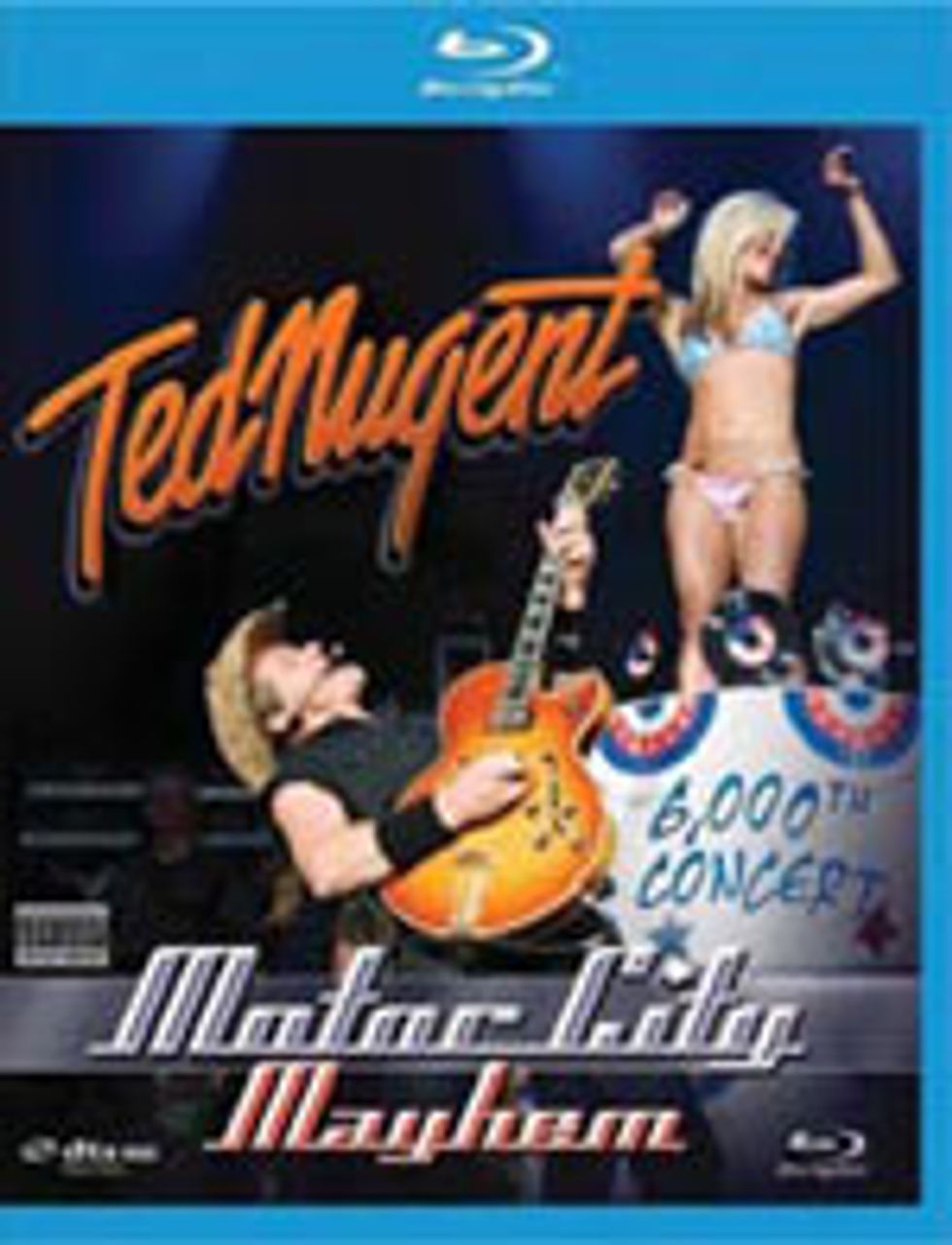 Ted Nugent has never been a proponent of understatement. His flashy, expressive guitar playing is only overshadowed by his exuberant and boisterous personality. For the aptly-named Motor City Madman’s 6000th performance, he chose to pay tribute to both his hometown and his country by ripping through a classic set of tunes on July 4th, 2008, in Detroit. The Nuge pulls out all the stops, complete with a huge birthday cake featuring a bikini-clad woman dancing on it. Available as a Blu-ray or DVD, and also as a double-disc live CD, Nugent and his solid backing band tear through such classics as “Wang Dang Sweet Poontang,” “Cat Scratch Fever” and the epic “Stranglehold,” which might be the best performance of the night. It’s clear that Nugent intended the show to be just as much a dedication to the birth of the country he so deeply loves as it was to commemorate his 6000th performance. He frequently peppers the music with patriotic screams and shouts, screaming the word “freedom” at the sky with a ferocity that wouldn’t expect from your average 60-year-old.
Ted Nugent has never been a proponent of understatement. His flashy, expressive guitar playing is only overshadowed by his exuberant and boisterous personality. For the aptly-named Motor City Madman’s 6000th performance, he chose to pay tribute to both his hometown and his country by ripping through a classic set of tunes on July 4th, 2008, in Detroit. The Nuge pulls out all the stops, complete with a huge birthday cake featuring a bikini-clad woman dancing on it. Available as a Blu-ray or DVD, and also as a double-disc live CD, Nugent and his solid backing band tear through such classics as “Wang Dang Sweet Poontang,” “Cat Scratch Fever” and the epic “Stranglehold,” which might be the best performance of the night. It’s clear that Nugent intended the show to be just as much a dedication to the birth of the country he so deeply loves as it was to commemorate his 6000th performance. He frequently peppers the music with patriotic screams and shouts, screaming the word “freedom” at the sky with a ferocity that wouldn’t expect from your average 60-year-old.The fact that most people know Nugent by his political and social views is a real shame, as evidenced by this impressive live performance. Love him or hate him, make no mistake: Ted Nugent is a very, very good guitarist, a fact that is, sadly, often upstaged by his political persona and pro-2nd Amendment ways. For those listeners who have never really given Nugent a chance because of his often polarizing qualities, Motor City Mayhem is a good place to start. The live performance of “Stranglehold” is worth the wait alone, accompanied with vocals by Nugent’s original rhythm guitarist, Derek St. Holmes. For those familiar with Nugent’s career, Motor City Mayhem is a must-buy. The flash, the spectacle, and most importantly the solid, fist-pumping rock ‘n’ roll that the man is known worldwide for is all here, and then some. For Nugent, it’s all part of the act. —JW
List $24.98
eaglerockent.com
Lenny Breau & Brad Terry: Live at the Maine Festival
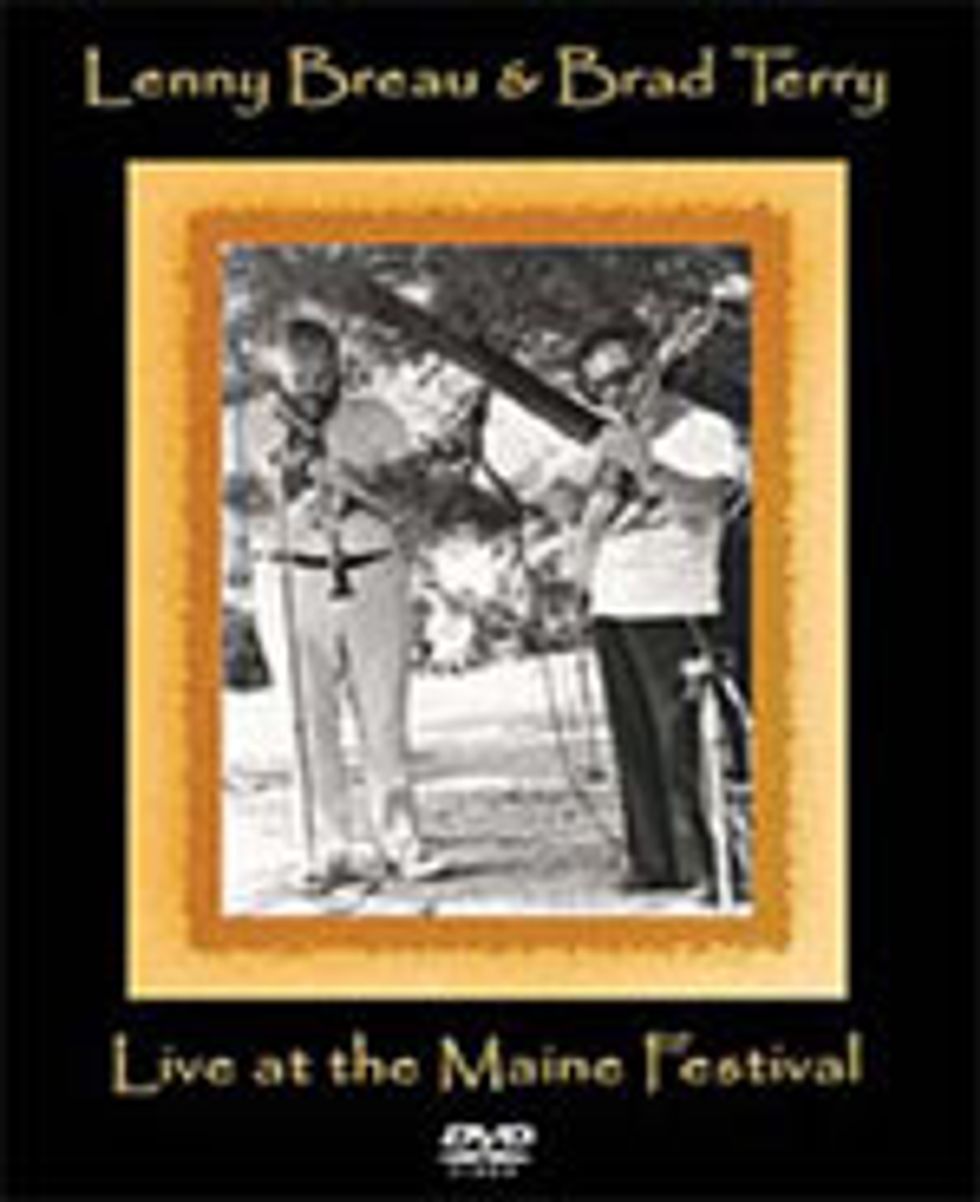 Lenny Breau is my all-time favorite guitar player. I knew him briefly and have listened to his music for 35 years. Breau has become as famous in music circles for his demons as he was for his unique and brilliant guitar picking. He was also a tenderhearted, witty human being who gave his life to music in ways few of us can imagine. His music could be spellbinding, and though some great solo jazz guitarists have come and gone, nobody played like Lenny Breau. His style so belongs to him that when someone else plays his licks, it’s obvious. So Breau has a small but very loyal following of guitar players who “get it,” and currently there are two record labels that are carrying the torch of Breau’s legacy: Randy Bachman’s Guitarchives and Paul Kohler’s Art of Life Records.
Lenny Breau is my all-time favorite guitar player. I knew him briefly and have listened to his music for 35 years. Breau has become as famous in music circles for his demons as he was for his unique and brilliant guitar picking. He was also a tenderhearted, witty human being who gave his life to music in ways few of us can imagine. His music could be spellbinding, and though some great solo jazz guitarists have come and gone, nobody played like Lenny Breau. His style so belongs to him that when someone else plays his licks, it’s obvious. So Breau has a small but very loyal following of guitar players who “get it,” and currently there are two record labels that are carrying the torch of Breau’s legacy: Randy Bachman’s Guitarchives and Paul Kohler’s Art of Life Records.Art of Life has released several CDs of Breau’s music and now a DVD. Live at the Maine Festival is far from perfect: the video quality is poor, as it was taken from old video. And it’s too short at thirty minutes and only two songs: “Emily” and “Autumn Leaves.” But the audio is good, and as far as I know this is the only video released (so far) that shows Breau playing his Dauphin nylon seven string. Sadly, we only see Breau in profile, so you can’t really cop his licks either. The good news is that the music is sublime. Breau is relaxed and playing beautifully. The sound of his guitar is rich and full, and Brad Terry is a damn fine clarinet player. The two of them have a nice dynamic together and are obviously winging it in classic jazz fashion. It’s a terrific performance, but at two songs it’s over way too quickly. The DVD includes two audio-only tracks and an interview with Brad Terry that includes some nice clips of him playing. Flawed as it is, this is a must have DVD for any fan of great guitar (and clarinet) playing. —PS
List $11.99
artofliferecords.com
Adam Rafferty Teaches How to Play the Music of Stevie Wonder
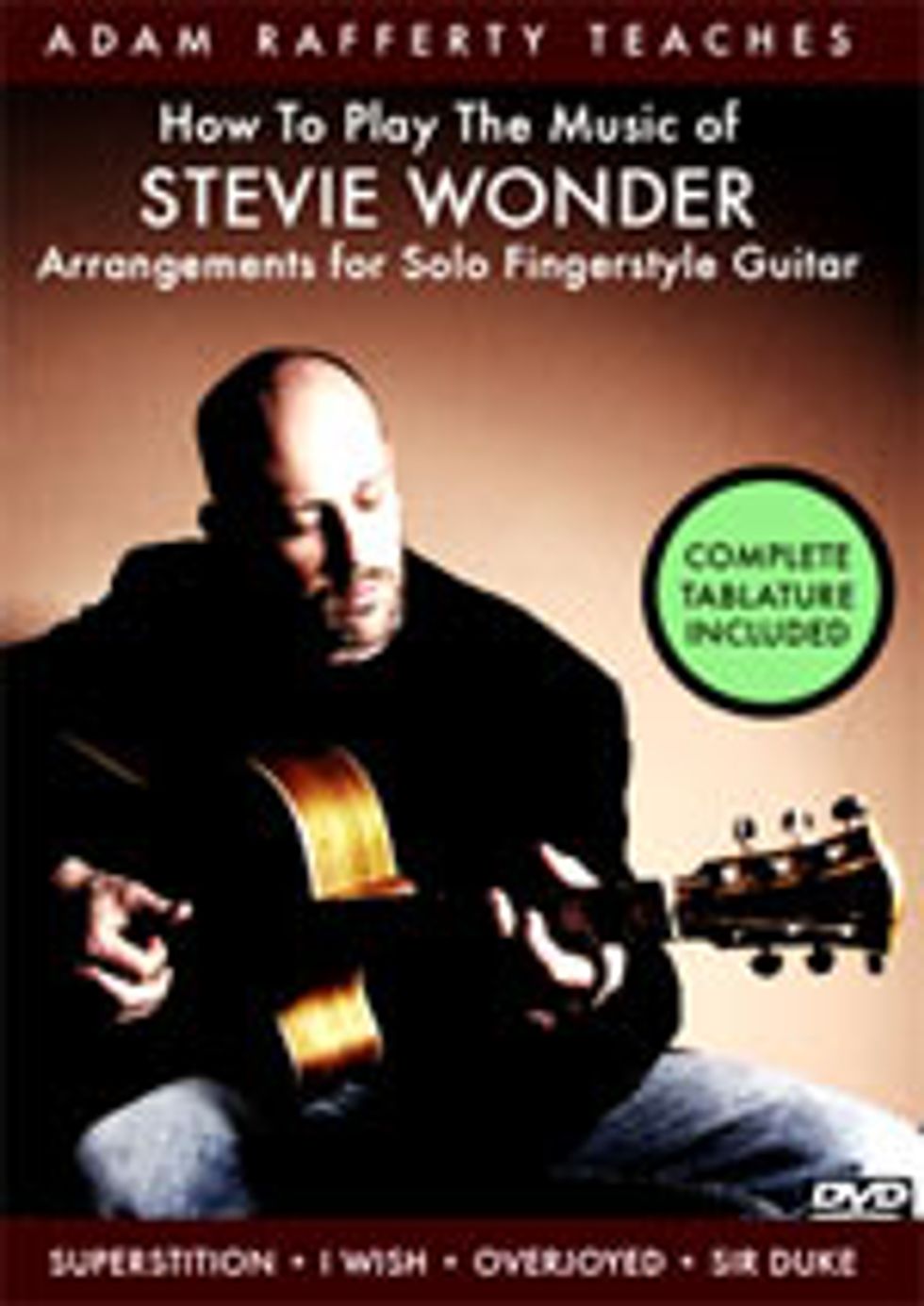 When we heard Adam Rafferty playing his arrangements of these tunes at the Cole Clark booth at NAMM in Nashville, we knew we had to look deeper. As it turns out, we weren’t the only ones who were won over by his interpretations. This DVD, he informed us, was motivated by the tidal wave of requests for notation, tab and instruction he received after he began posting videos of the songs on YouTube. Stevie Wonder probably never knew he was writing songs for solo guitar performance, but Rafferty’s arrangements make it seem like that’s what he meant all along. It’s a joy just to watch him play the four Wonder songs offered here (“Overjoyed,” “Superstition,” “Sir Duke” and “I Wish”), but the instruction sections are also jam packed with performance and arranging tips, and pure inspiration. With split-screen and step-by-step instruction that ranges from guitar performance to syncopation and music theory that is instantly applied to the fretboard, as well as an accompanying booklet with complete music and tab, it’s a master class in a box (and Rafferty’s Cole-Clark FL2AC sounds gorgeous, too). —CB
When we heard Adam Rafferty playing his arrangements of these tunes at the Cole Clark booth at NAMM in Nashville, we knew we had to look deeper. As it turns out, we weren’t the only ones who were won over by his interpretations. This DVD, he informed us, was motivated by the tidal wave of requests for notation, tab and instruction he received after he began posting videos of the songs on YouTube. Stevie Wonder probably never knew he was writing songs for solo guitar performance, but Rafferty’s arrangements make it seem like that’s what he meant all along. It’s a joy just to watch him play the four Wonder songs offered here (“Overjoyed,” “Superstition,” “Sir Duke” and “I Wish”), but the instruction sections are also jam packed with performance and arranging tips, and pure inspiration. With split-screen and step-by-step instruction that ranges from guitar performance to syncopation and music theory that is instantly applied to the fretboard, as well as an accompanying booklet with complete music and tab, it’s a master class in a box (and Rafferty’s Cole-Clark FL2AC sounds gorgeous, too). —CB List $34.97
adamrafferty.com
Exploring Jazz Guitar
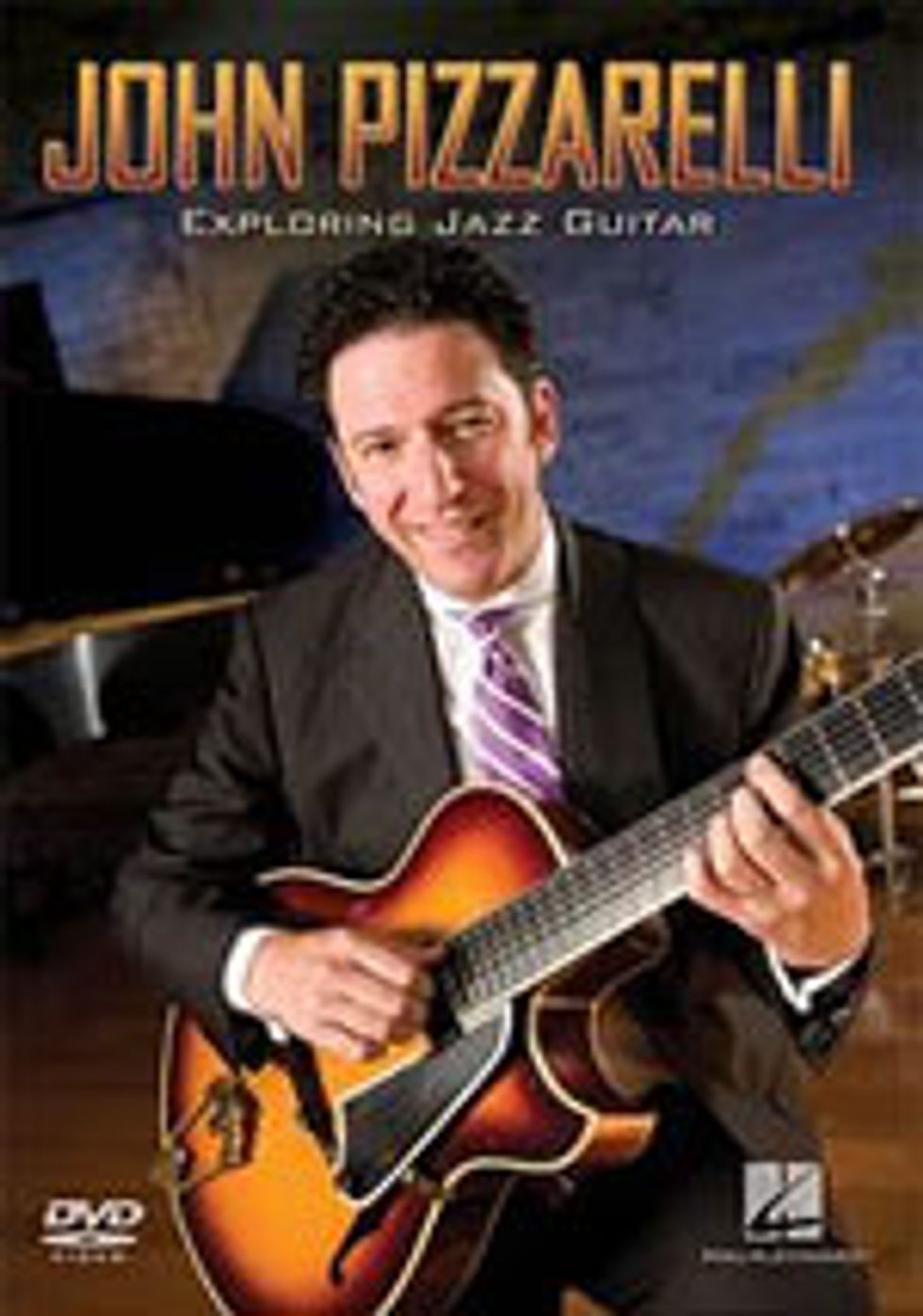 John Pizzarelli carries the jazz guitar torch direct from the old school. His dad is the great Bucky Pizzarelli, and Bucky played with all the old jazz guys you can think of, as well as doing a ton of studio work. John grew up surrounded by jazz and obviously soaked it right up. He is a darn fine picker and a good jazz singer as well. If you haven’t heard John, check out his public radio show called Radio Deluxe. He also has a pretty vast catalog of CDs, too. So now imagine getting to hang with John and have him show you a bunch of cool jazz guitar stuff—but wait! You don’t have to imagine it ‘cause here it is on this DVD.
John Pizzarelli carries the jazz guitar torch direct from the old school. His dad is the great Bucky Pizzarelli, and Bucky played with all the old jazz guys you can think of, as well as doing a ton of studio work. John grew up surrounded by jazz and obviously soaked it right up. He is a darn fine picker and a good jazz singer as well. If you haven’t heard John, check out his public radio show called Radio Deluxe. He also has a pretty vast catalog of CDs, too. So now imagine getting to hang with John and have him show you a bunch of cool jazz guitar stuff—but wait! You don’t have to imagine it ‘cause here it is on this DVD.John is an engaging guy; he is excited about this music and it shows. His tone is lovely, woody and rich on his signature Moll 7-string. He starts by showing you the gear he uses, which is always fun for us PG folks. Then he moves through various comping styles and tells you not just what to play, but gives some pointers on using the material tastefully. He covers reharmonizing the blues in one chapter, and the DVD is worth getting just for that. Both Pizzarellis play great rhythm guitar, and John gives you a lot of information here. There is also a nice chapter on single line playing. This is a must have DVD for any student of jazz guitar. —PS
List $29.99
halleonard.com
Folk Blues for Fingerstyle Guitar with Stefan Grossman and A Guitar Lesson with David Bromberg
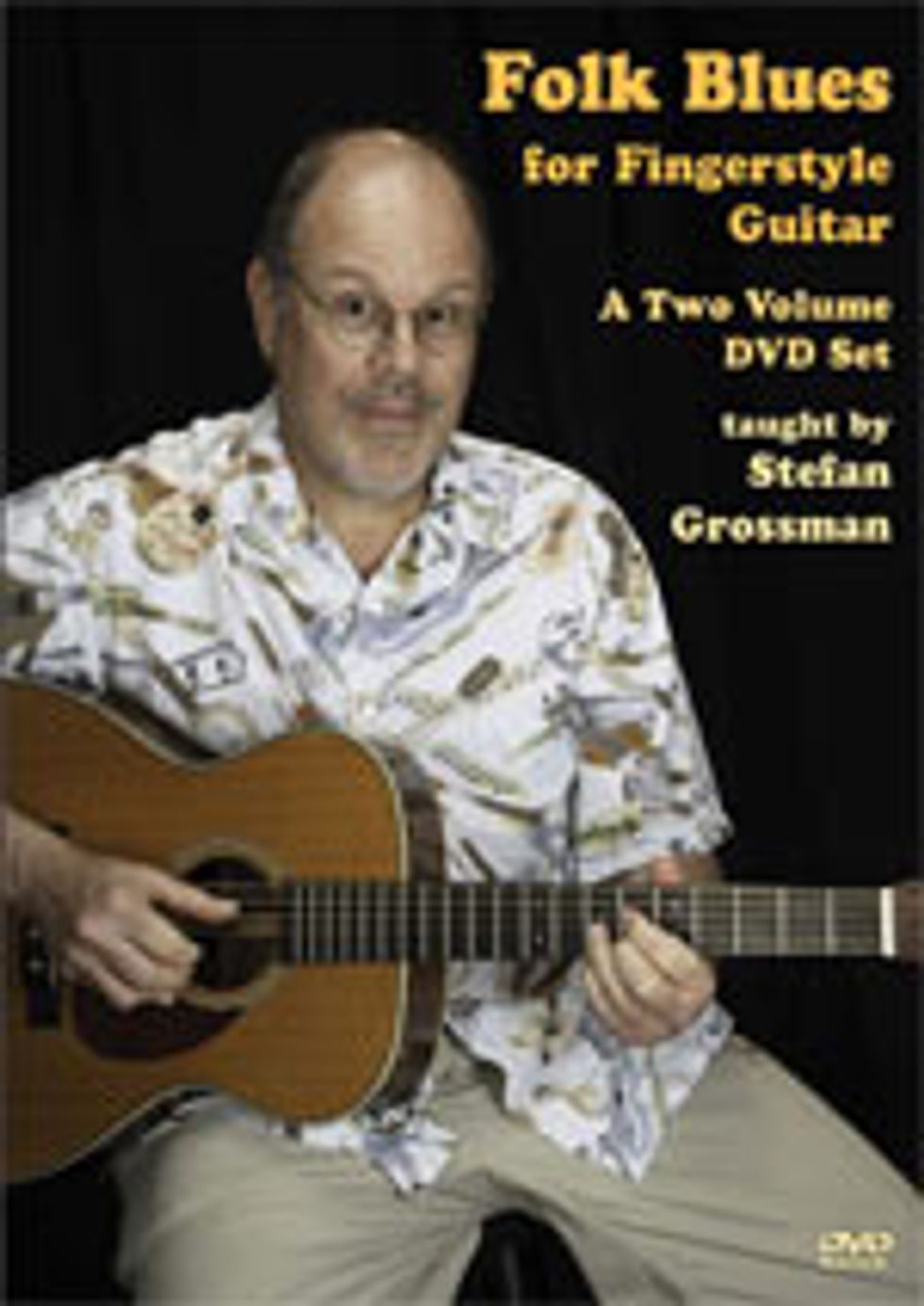 |
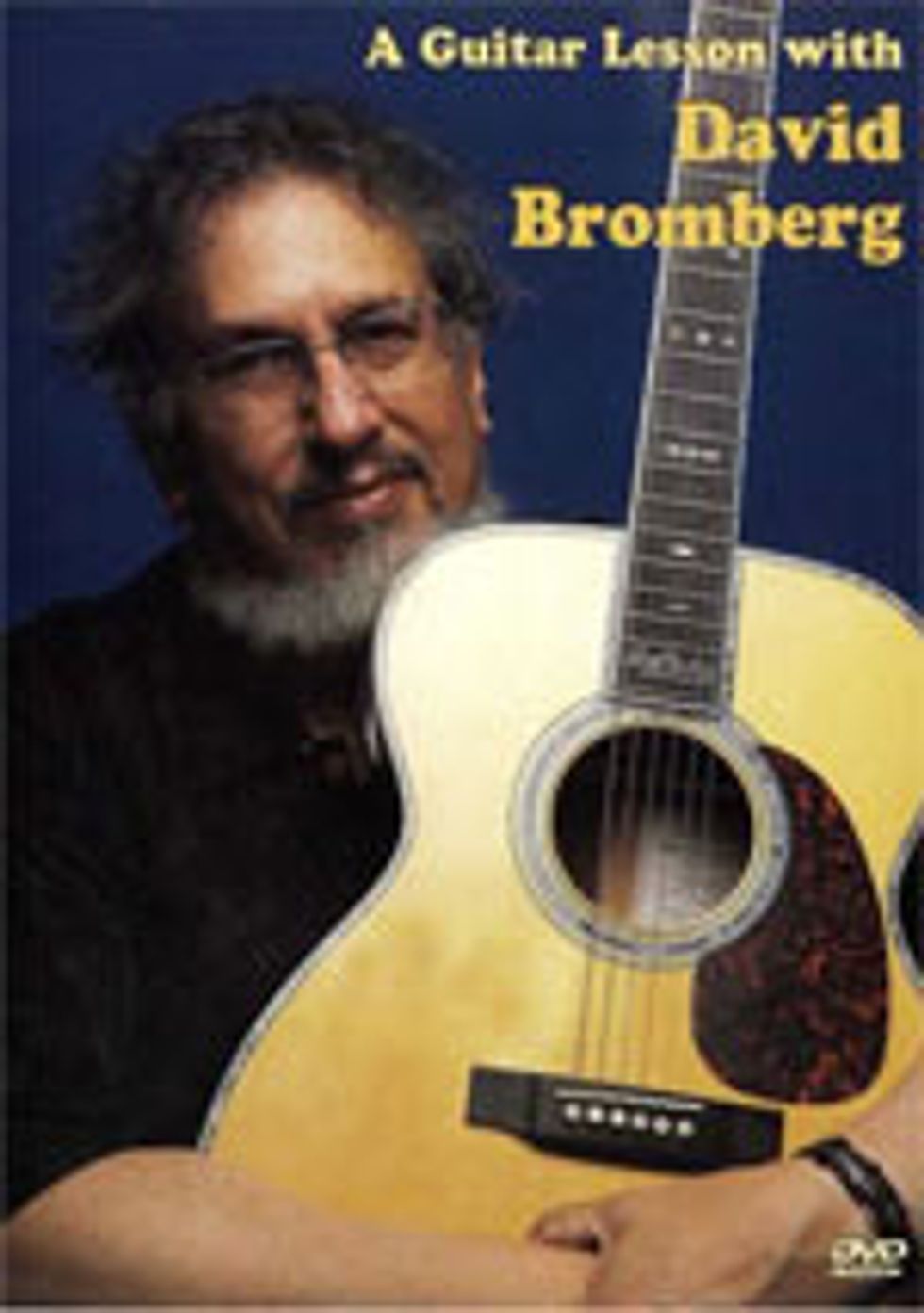 |
Grossman is a wonderfully supportive and reassuring presence throughout the lessons, which start with some basic folk blues and progress fairly quickly to more advanced left- and righthand chops. I love the fact the Grossman courses contain “homework”—audio tracks of these traditional blues songs from recordings made in the ‘20s and ‘30s that Grossman urges the student to spend some time with before attempting to play. He also gives a little historical perspective on the tune, and talks about some of the additional recordings, to give you a real sense of connection to a tune before he plays a note of it. Disc One covers universal playing ideas like economy of movement, chord substitutions and additional voicings, damping and muting, slides, bends, and hammer-ons/ pull-offs, in addition to teaching these blues arrangements step-by-step with instruction, and slowed down in split screen so you can play along. Disc Two covers altered tunings including Drop-D, DADGAD, Open D and Open C, right-hand rolls and double-stopping, and gives helpful tricks and ideas for expanding your playing and arranging your own tunes. Notation and tab for each of the tunes are available in an included booklet and as PDFs on the disc.
Bromberg’s lesson covers some of his most popular arrangements, from traditional folk blues to early folk rock. He covers concepts like parallel and contrary motion between bass lines and melodies, the intricacies of Rev. Gary Davis-style right-hand, single-finger rolls, use of diminished chords in traditional blues and the challenge of playing under a talking blues that doesn’t necessarily follow the groove your hands are laying down. This is not easy, beginner stuff. It’s tough and meaty, and Bromberg does a great job slowing everything down and showing you many possible variations of a lot of licks. He also tells you if he got a lick from somebody else, like the Rev. Gary, so you can do some additional listening. The format is the same as the Grossman discs, with separate audio tracks of the tunes, step-by-step instruction and slow split-screen with the entire tune. Audio and video quality on both discs is top notch. Notation and tab are once again available in the included booklet and as PDFs on the disc.
Grossman and Bromberg’s laid-back attitudes and relaxed mastery make the lessons engaging, and the format makes them immediately applicable to the fretboard. —GDP
List $39.95 – Stefan Grossman DVD
List $29.95 – David Bromberg DVD
guitarvideos.com
Books
Confessions of a Record Producer: 10th Anniversary Edition, Revised and Updated
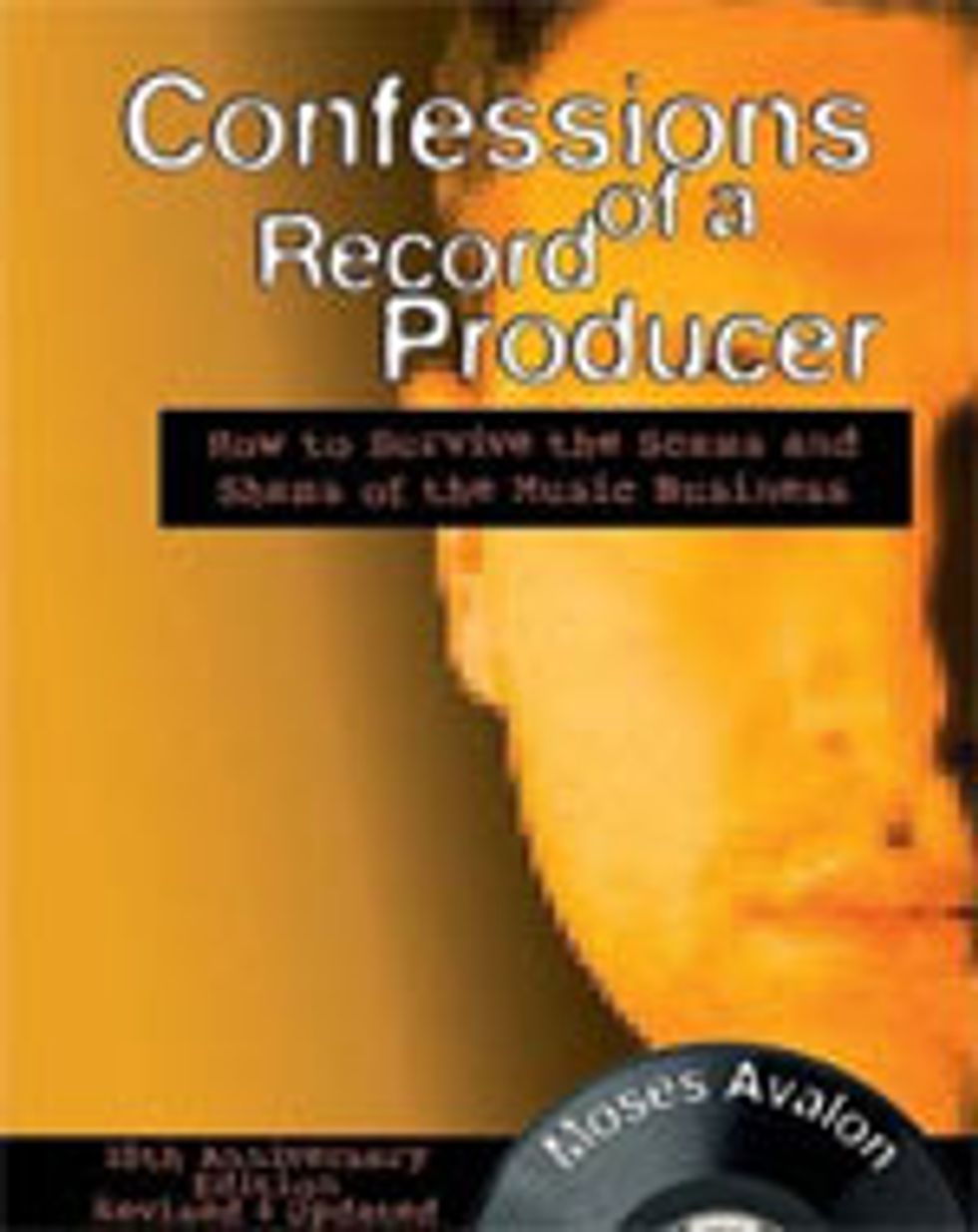 A decade ago, Moses Avalon wrote the groundbreaking and slightly terrifying Confessions of a Record Producer, in which he turned the music industry inside out to give outsiders a real taste of its inner workings. Since then, the music business has undergone some dramatic transformations wrought by the expansion of internet marketing, music downloads and the indie revolution, and Avalon decided it was time to bring his no-bullshit rough guide to the underbelly of the music biz up-to-date. This time, he includes a DVD-ROM with lessons from Avalon’s Workshop and bonus reference materials for those who want to dive in deep.
A decade ago, Moses Avalon wrote the groundbreaking and slightly terrifying Confessions of a Record Producer, in which he turned the music industry inside out to give outsiders a real taste of its inner workings. Since then, the music business has undergone some dramatic transformations wrought by the expansion of internet marketing, music downloads and the indie revolution, and Avalon decided it was time to bring his no-bullshit rough guide to the underbelly of the music biz up-to-date. This time, he includes a DVD-ROM with lessons from Avalon’s Workshop and bonus reference materials for those who want to dive in deep.By looking at a model first recording contract of a fictitious artist from three angles—the artist,the producer and the label—he gives us a very clear picture of the way this game is played, who the various players are, what everybody’s real role is, how they’re all trying to rip everybody else off—and why the artist is usually playing to lose from the start. He shows us the math, too. How many albums have to sell before the artist stops hemorrhaging money and breaks even? How many years will an aspiring engineer/producer have to work as an unpaid intern until they can catch a break and start making a subsistence living, and how long until they can actually start producing anything at all? What percentage of new artists in one year is a label really willing to get behind, and how many will end up cutting tracks that will never, ever see the light of day? And just how do digital downloads impact artist royalties?
Perhaps most importantly, Avalon tells us how artists can protect themselves from the worst of it, what labels will slip into contracts hoping the artist won’t understand or notice, and what smart artists may be able to negotiate away. If you have any aspirations of playing the major-label game, this book should be on your bookshelf. —GDP
List $24.99
backbeatbooks.com
Black Tooth Grin: The High Life, Good Times, and Tragic End of “Dimebag” Darrell Abbott
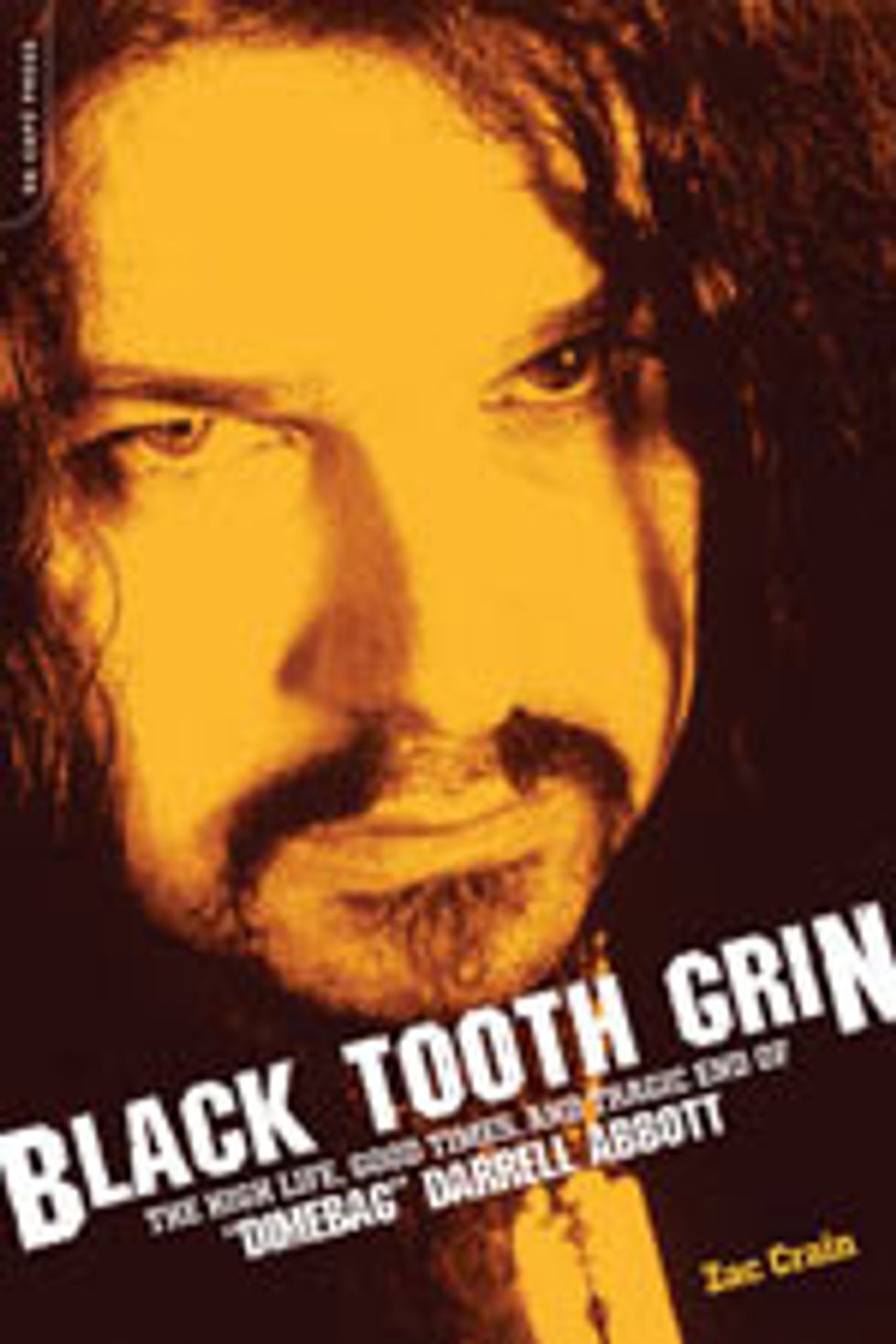 With a nickname like “Dimebag” and reputation for blurring the lines between one party and the next, Darrell “Dimebag” Abbott has a spot reserved for only the most legendary rock ‘n’ roll party animals. And with a title like Black Tooth Grin (a cocktail preferred by Abbott, which is Crown with a splash of Coke) you’d expect nothing but tour bus and backstage tales of excess and debauchery.
With a nickname like “Dimebag” and reputation for blurring the lines between one party and the next, Darrell “Dimebag” Abbott has a spot reserved for only the most legendary rock ‘n’ roll party animals. And with a title like Black Tooth Grin (a cocktail preferred by Abbott, which is Crown with a splash of Coke) you’d expect nothing but tour bus and backstage tales of excess and debauchery.While author Zac Crain does include such stories from bundles of sources, the book’s heart lies in a message that doesn’t glorify Abbott’s well-known antics, but instead humanizes the prolific partier and shredder. When stripped to his core, he was just a music fan who loved to play his guitar.
Crain uses a loose chronological timeline to direct the narrative about Abbott’s beginnings to his time on top of the metal world in the mid ‘90s and his eventual murder. After forming Pantera in ‘81 and spending years on the Texas club circuit—Abbott’s parents often had to be attendance just to get Darrell inside—the planets aligned for Pantera and their fifth studio release, Cowboys From Hell, as it launched them into the metal spotlight. Building off this success well into the ‘90s, Pantera continued to dominate metal playlists, but one thing remained unchanged: Abbott’s status as fan first, rock star second. Whether it meant signing autographs for hours, doing free guitar clinics with fans or waiting in line with the general public at guitar stores, he still kept the same demeanor as the kid who first played air guitar to KISS albums.
Black Tooth Grin provides a well-rounded, introspective look into Abbott’s world as music fan, guitarist, party ambassador and mama’s boy—Abbott never lived farther than 10 minutes from his mother. But as his celebrated story unfolds, the fact that Abbott was nothing more than a lucky fan becomes more evident. A quote from original Pantera lead-singer Terry Glaze says it all, “if you would have told Darrell that, when you die, Van Halen is going to put the guitar from Van Halen II in your casket, Darrell would have said, ‘Kill me now.’” And that’s something nearly every fan can agree with. —CK
List $15.95
dacapopress.com
Battle of The Band Names: The Best and Worst Band Names Ever (and All the Brilliant, Colorful, Stupid Ones in Between)
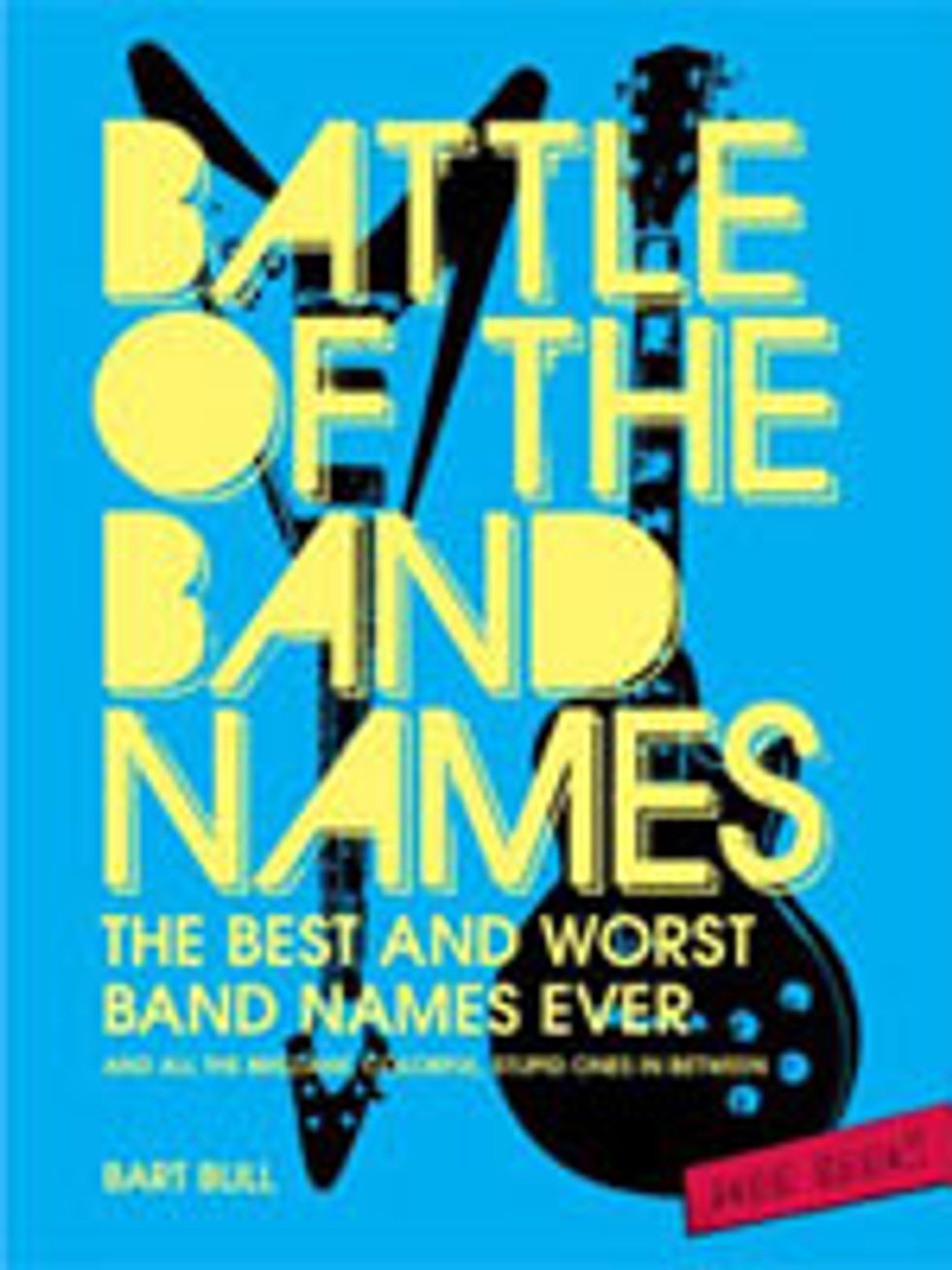 Does a band name really matter? Ever wonder if Joe Strummer and company would’ve been as successful without a name like the Clash? Likely. Would U2 have the cultural significance and popularity with a different name? Probably. Then again, why haven’t acts like Milk Robber, Kannivalism or the Mountain Playboys taken off? Maybe there’s something to be said for a first impression… even when it comes to band names.
Does a band name really matter? Ever wonder if Joe Strummer and company would’ve been as successful without a name like the Clash? Likely. Would U2 have the cultural significance and popularity with a different name? Probably. Then again, why haven’t acts like Milk Robber, Kannivalism or the Mountain Playboys taken off? Maybe there’s something to be said for a first impression… even when it comes to band names.In Battle of the Band Names, author Bart Bull, former editor of Spin and DETAILS, compiles a huge list of band names in 35 wacky chapters to show what happens when language, music, pop culture and egotism converge. The chapters are broken down categories such as musical genre, mythical creatures, metallurgy, the color pink, tribute bands and Japan-based names. Not only does Bull do a great job adding snarky commentary at the beginning of each chapter to set the stage, but the book is colorfully designed and laid out in a way that’s as entertaining for the eyes as the text is for the temporal lobe.
While Bull covers the known bands and genres over the past 50 years, the real treat of this tongue-in-cheek book is in the chapters dedicated to the not-so-familiar band names like Bald Guys in Bow Ties. He guides you along the path of musical history that’s evenly sprinkled with band names from the outrageous and idiotic to the thoughtful and brilliant. So next time you’re brainstorming for names, check Bull’s book so you know that names like Papaya Paranoia or Kiiiiiii have already been tried. —CK
List $15.95
abramsbooks.com
A story of friendship and Dimebag''s famous "Dean from Hell" ML
A short, teenage boy equipped with twigs for appendages hides behind his weapon of choice: a cherry sunburst Dean. With the guitar covering most of his torso, the adolescent is about to embark into a world of scrupulous eyes and experienced, calloused fingers. Although he’s one of the youngest competitors, he looks calm, refreshed and at home all alone on the stage. The judges prepare their scorecards, the crowd continues to settle in and several contestants snicker at the prospect of this ‘child’ surpassing their skill and talent levels. As the spotlight recedes from the back of the room and greets the youngster with a bright ‘hello,’ his teased and feathered brown hair is saturated with sweat. Not the sweat of a nervous novice, but the anticipatory perspiration of victory and confidence. The audience and fellow competitors are about to learn a lesson: looks can be deceiving.
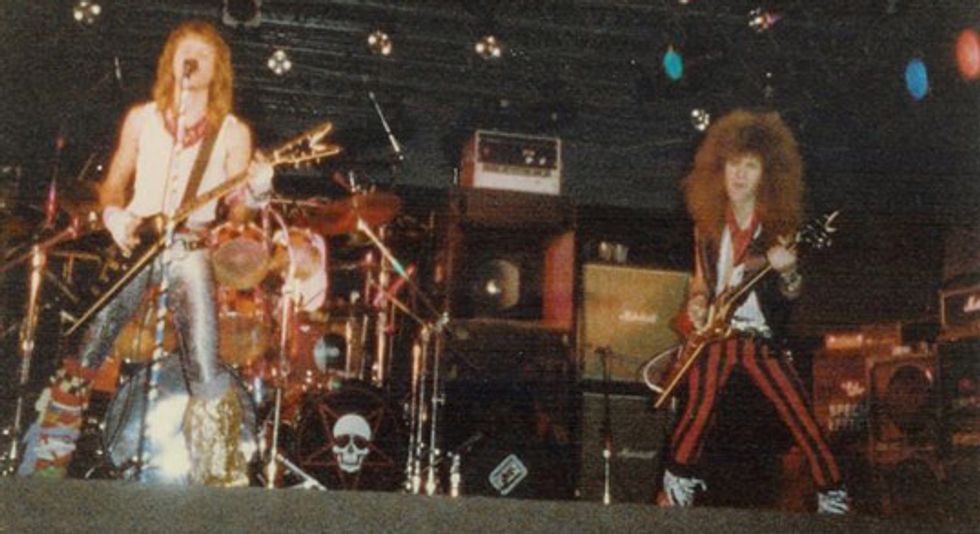 Terry Glaze singing and playing rhythm while Darrell shreds |
As Terry Glaze, Pantera’s original lead singer, continues to retell this story of young Darrell “Dimebag” Abbott, I realized this was a fit beginning to a storied career.
“I remember one time particularly when Darrell went into his room and woodshed for about six months,” said Glaze. “He came out of that room and played like he would the rest of his life. I don’t know what happened in there, but he could really play after locking himself in that room for those weeks.”
When Darrell plugged in and hit his first chords, the laughter and mocking subsided and the lesson began. Carefully playing through renditions of Randy Rhoads’ and Eddie Van Halen’s solos, Abbott left the best for last. The icing on the cake for this performance wasn’t Darrell’s spontaneous variations of his idol’s songs, but when he performed his own material. On this fateful day in 1982 at the Arnold & Morgan Guitar Contest at the Ritz in Dallas, not only was a star born, but an iconic guitar and the resulting friendship began its start down an unprecedented path.
Young Darrell swaggered out taller as he carried his trusted cherry sunburst Dean and a newly acquired maroon Dean ML guitar. He had unanimously won the contest. All young Darrell wanted was to play Dean guitars, especially this ML. It was his destiny to not only play Deans, but later develop a signature series, even if he didn’t realize until much later in life.
“I remember there were a lot of good guitar players, but Darrell was so much more than anyone, there was no doubt about it,” said Glaze. “They had to make him a competition judge pretty quickly because no one was even close to him.”
Although Darrell astonished fans and fellow band members with his playing style and ferocity on stage, he often was confronted with skepticism because of his age or size. However, Darrell quickly converted the non-believers to his shred religion.
“The first time I saw him play I thought, ‘this kid is okay,’ but nothing special because they were only playing an 20-minute opening set which didn’t allow Darrell to solo or improvise,” said Buddy Blaze, life-long friend of Darrell. “At a later date with a longer set, he played some solos and improvisational stuff. My jaw hit the floor because it was so good, but it came from someone so young.”
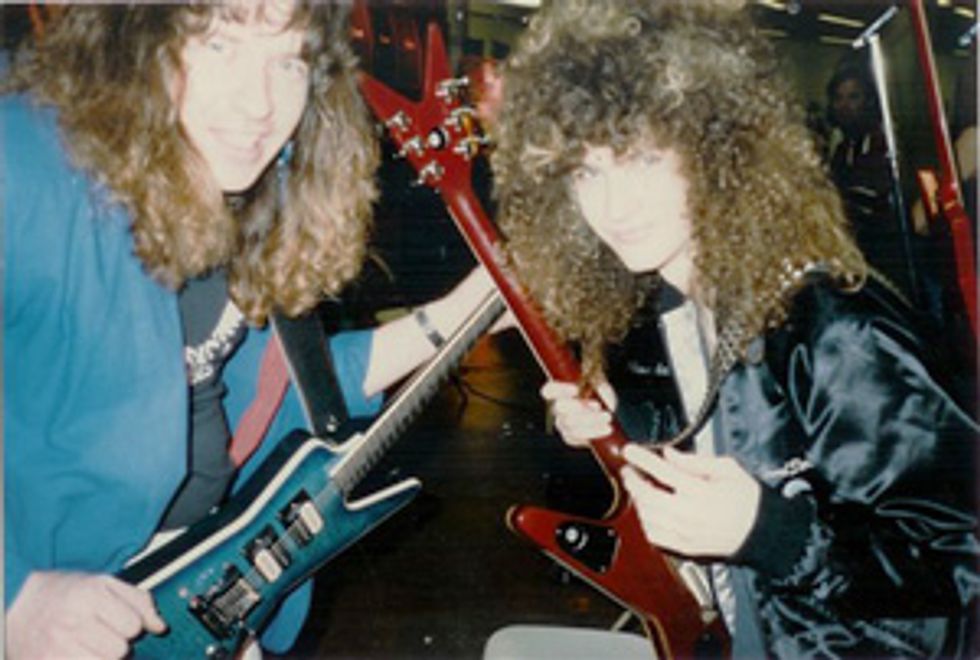 Buddy Blaze and Darrell letting the good times roll |
“We’d play originals and Darrell would just crush people. He always loved to play like that because he was just a big kid,” said Glaze.
Soon after watching Darrell rip on stage, Blaze quickly found himself levitating towards Darrell and his regionally-known band, Pantera. Although Darrell was several years younger than Blaze (who was already married), they were friends instantly because of one thing: Dean guitars. They both loved the playability, the V-ed out neck’s low action and the fact that not many people in Texas played the Chicago-based guitars.
It was a match made in heaven for Dean and Darrell. For no other reason than “tone; Darrell always had the thickest, coolest tone,” said Glaze.
Darrell’s sound evolved over the years, but his core, signature tone has always been there, from the early days of the hair-metal Pantera to the power-groove vibe that rocked the nineties. It all began with a simple formula: a few effects and near-intolerable volume. He used a Yamaha amp and a blue MXR six-band graphic EQ; he occasionally also used a MXR Harmonizer. Because Pantera had a deal with Randall – which blossomed from another Darrell guitar competition victory – they were able to use stacks and stacks of cabinets. Some were loaded while others remained empty; Darrell would place the Yamaha amp either behind or inside them, then he would blend the Yamaha tone through the Randall stacks. Darrell also took a page from his idols’ playbooks by slightly and incrementally adjusting the pitch on his Harmonizer and intricately blending that into his tone.
“I know because of the times that it was like Motley Crue and Judas Priest with my high-pitched screams and falsetto singing, but the tone and sound of Darrell’s guitar is still the same,” said Glaze. “Someone who is a fan of Pantera from the mid-nineties will be able to listen to the earlier stuff and be like, ‘Hey, that’s Darrell playing guitar’.”
While Darrell and the rest of Pantera enjoyed increasing regional success throughout Texas in the mid-eighties, Blaze became more visible at not only Darrell’s side, but with the rest of the Abbott family.
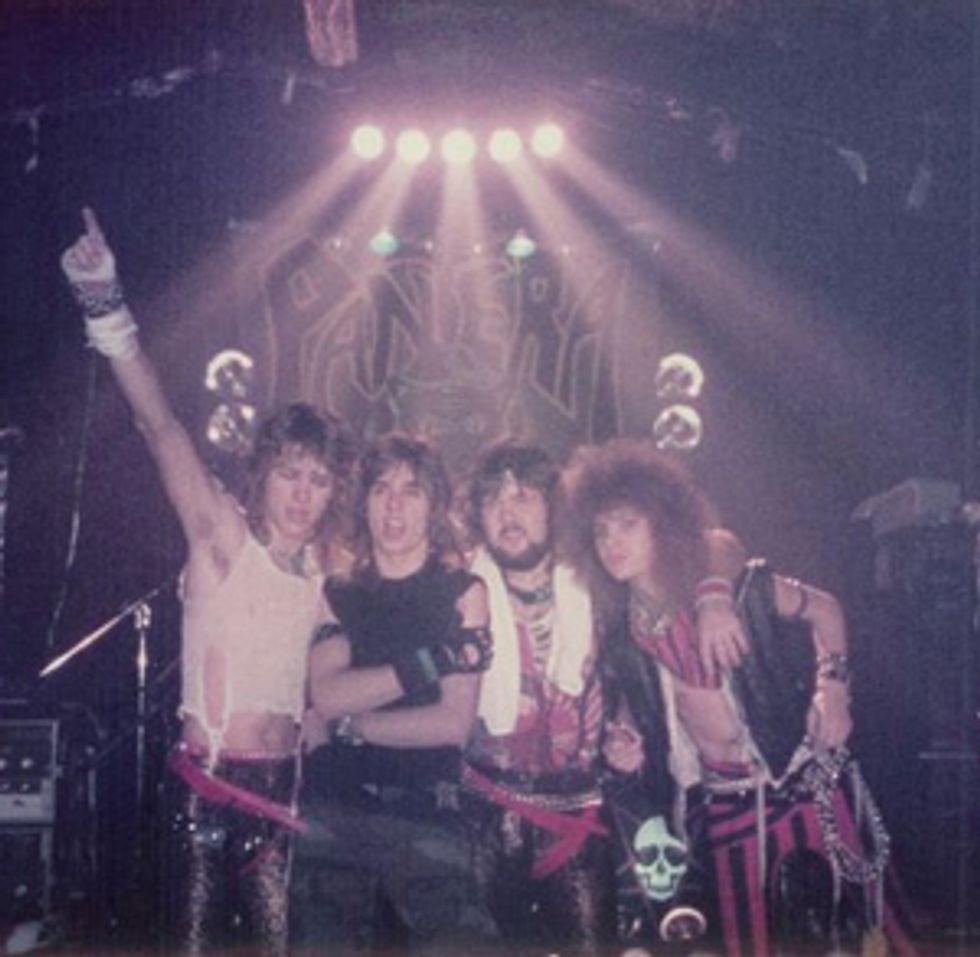 Mid-eighties Pantera cruising through the Texas circuit |
He reached the age where the lines of freedom and delinquency can become blurred. Abbott was about to commit a musical sin and he turned to his close friend for help.
“He came to me several times, asking if I’d buy that Dean ML that he won at the contest. I wouldn’t because you don’t sell trophies,” said Blaze. “I told Darrell that when he’s 50 and surrounded by grandkids he can tell them their grandpa won this guitar when he was 14.”
But, the inexperienced Darrell disregarded Blaze’s advice and continued his search for a potential buyer. Darrell was determined to buy a yellow Firebird and was willing to do whatever it took to get behind the wheel, which ultimately meant selling the trophy guitar.
Abbott sold the guitar to Blaze’s bandmate. Later that same day Blaze encountered the newly exchanged guitar.
“I just remember being at band practice and my lead singer came in with a guitar case shaped like a Dean ML,” said Blaze. “I knew once he opened the case and I saw Darrell’s Dean ML that he wasn’t leaving practice with that guitar.”
Blaze and his lead singer negotiated and finally settled on a fair deal. Blaze had just bought a brand new Kramer Pacer – “The best guitar I had in my own hands” – and traded it to the lead singer for Abbott’s Dean ML. Although it didn’t belong to the rightful owner, it was under the watchful eye of a close friend.
As for Darrell – now in possession of the Firebird – his reputation spread around town for not only being a hot guitar player but for his fast and foolish driving habits. The car spent more time parked than in the fast lane because Darrell quickly racked up numerous tickets and warrants.
“Darrell’s yellow Firebird was hilarious, a real Smokey and the Bandit thing,” said Glaze. “Back then, Darrell only weighed 115-120 lbs. He would just fly around town with his big, curly hair inside that Firebird.”
As for the low-key Dean and Blaze, a month passed before Buddy Blaze realized something was out of place. His newly acquired Dean ML guitar was maroon and all of his other guitars were blue, so Blaze thought a new paint job would welcome it into his guitar family. But instead of a standard blue paint job, he decided on a lightning storm scene. Blaze tapped into his fascination with storms and browsed through several National Geographic magazines to find a good reference. Despite the planning, Blaze didn’t warm up to the new paint scheme until months later.
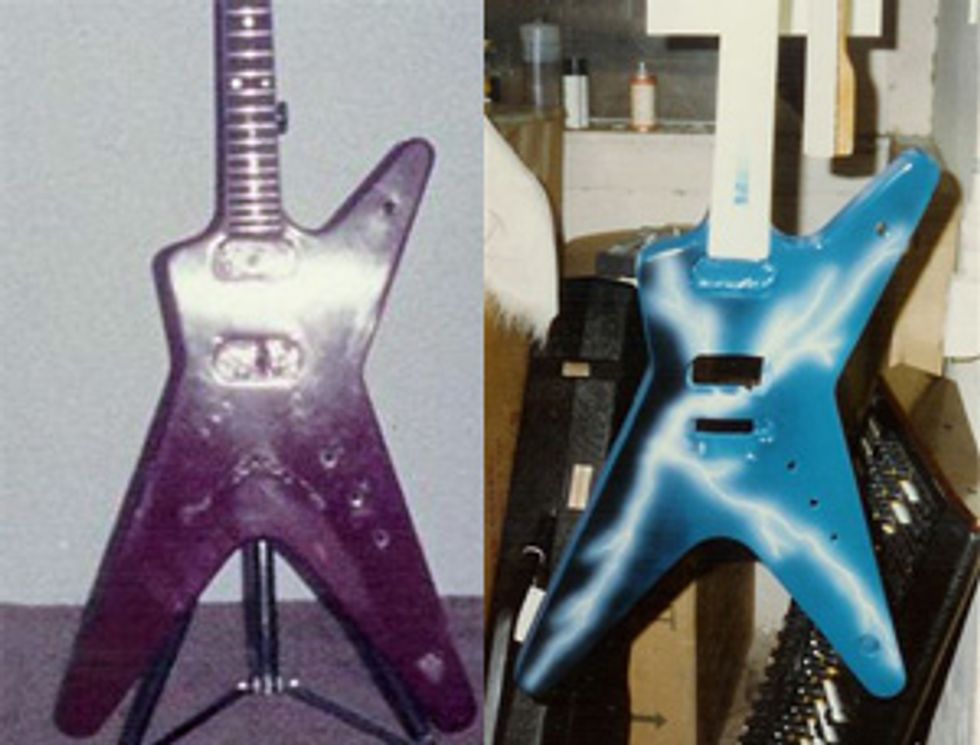 The "Dean From Hell" before and after its new paint job |
Darrell came over to Blaze’s house and saw this mysterious new guitar in Blaze’s collection. “I wasn’t sure if Darrell knew this was the same Dean ML he won years ago as a teenager,” said Blaze. “We just never really talked about it. I don’t even know if he knew I owned his guitar.”
Blaze continued to jam with his newest axe, but things just didn’t feel right. It was the perfect color, the preferred pickups and the desired setup, but the guitar still felt out of place.
“I remember the first time Darrell put on the guitar and started playing it. I realized right there and then that all the modifications I did for myself on the guitar were for nothing because it wasn’t even my guitar,” said Blaze. “But still to this day, that is my favorite guitar. If I could pick just one guitar to have forever, it’d be that one.”
As months tend to pass like a blur, Pantera and Blaze found themselves at a crossroad. Pantera had just recruited Philip Anselmo, a new lead singer, and were heading into the studio to record their fourth album Power Metal. Blaze also had opportunity knocking on his door. Kramer guitars had contacted Blaze and offered him a lucrative deal to move to New Jersey and help produce custom guitars.
“I saw the writing on the wall. It was my time to leave and Pantera was about to hit it big,” said Blaze. “I did what I felt was right in my heart and told Darrell to borrow my guitar until I could make him a copy.”
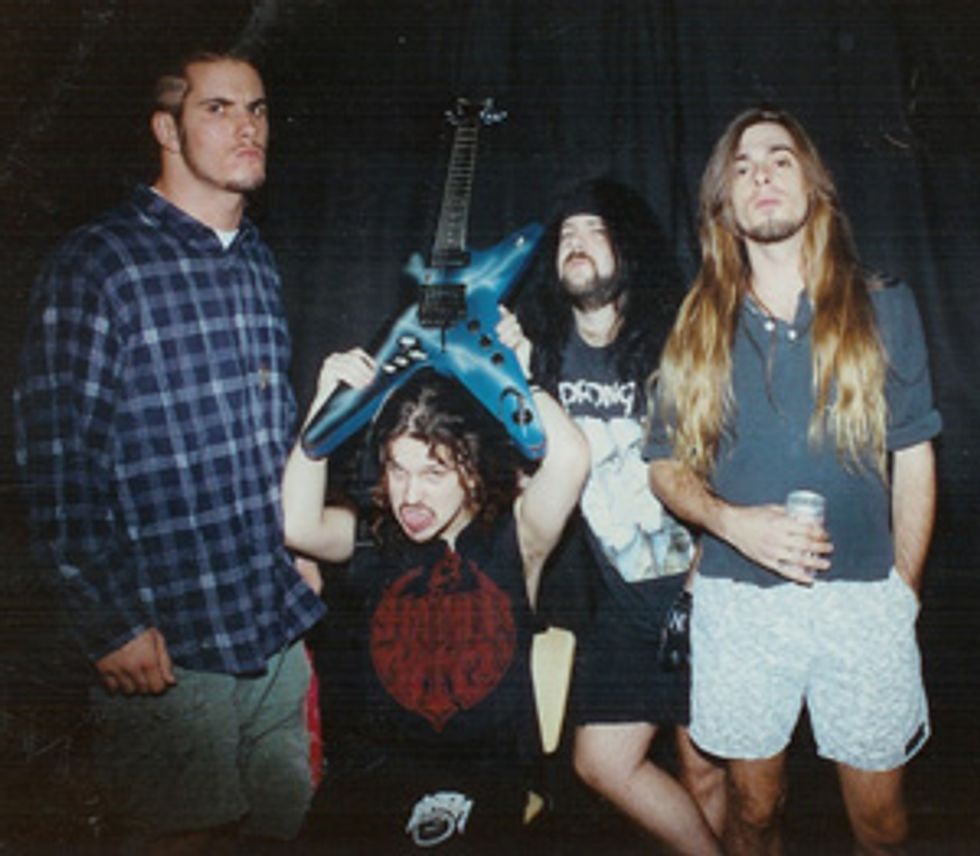 Early-nineties Pantera finding a new level of power |
“Dude, I really love this guitar, but I don’t want to scratch or ding it up. It’s not even my guitar,” said Darrell.
Blaze quickly responded. “Don’t worry about it Darrell. Some day when you’re a superstar I’ll brag to my friends and family that Darrell Abbott scratched it.” With that, the frantic phone call was subdued and the conversation shifted.
Only a few weeks had passed and Darrell frantically called yet again, “Dude, what is it going to take for me to own this guitar, Buddy? I can’t let this guitar go!”
Blaze took a few moments and explained the situation. “Darrell you remember when you tried selling me that red ML and I didn’t buy it? You remember me telling you that you don’t sell your trophies? You got lucky this time because that lightning guitar is your red ML, your trophy guitar, so just keep it man. It was always yours and it’s yours again.”
Blaze vividly remembers the conversation, still to this day. “If you knew Darrell at all, when I told him this he just went ballistic – doing his yelling, screaming, jumping and running antics.” With a reaction like that, Blaze knew the guitar was back home.
Darrell was always a fan first and that was no more evident than his love for Blaze’s work. He was just as consumed with excitement when he received that lightning bolt Dean as the thousands of fans who shared moments, laughs, photos and even a few Black Tooth Grins – Crown Royal or Seagrams 7 with a splash of coke – with Dimebag.
As history can corroborate, Pantera went on to become a metal juggernaut in the nineties and Blaze has since developed numerous guitars and even his own guitar company. The guitar modified and adapted by Blaze became the prototype in 2004 for Dimebag’s signature series, which was released by Dean – now based in Tampa Bay – in 2005 at Winter NAMM. Ironically, the guitar groomed by Blaze and later adopted as Dimebag’s preferred axe, was used to depict Abbott’s likeness at his funeral and memorial service. The guitar stood on stage, illuminated to the heavens by a spotlight, while Darrell’s friends and colleagues spoke about the guitar legend.
Due to Dean’s financial troubles in the mid-nineties, Darrell joined the Washburn team where they developed a few signature models. Blaze recalls Darrell being happy with the move, but not quite feeling right.
“Let’s just say this, I’m glad that prior to his death he hooked back up with Dean guitars and they coincidentally developed the Dean from Hell based on the lightning bolt specifications,” said Blaze. “I know Darrell always wanted to play Deans, even way back when he first started. It was just good to see him back where he belonged.”
Even Dean’s CEO Elliott Rubinson recognizes the importance of Darrell’s endorsement of the once struggling guitar company.
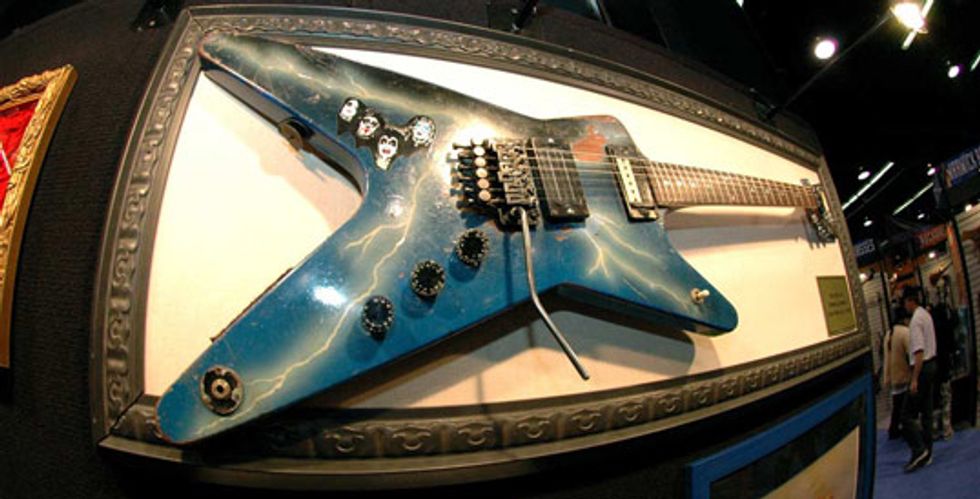 The DFH on display, after years of lovin'' abuse |
“Because Darrell played Deans throughout his career, I believe he played a large part in keeping the name in people’s minds, even when the company battled financial woes,” said Rubinson. “Only if that guitar could talk, the burnt headstock from Darrell’s fireworks, the KISS sticker and the paint scheme are all Darrell. People see the guitar they instantly think of Dimebag.”
For any guitar owner or builder, they have a special spot for their beloved projects. However guitars are just wooden instruments and lifelong friendships can be harder to build.
“It was my number one guitar, but that just shows the love I had for Darrell,” said Blaze.
With the gift that keeps on giving, the guitar exemplified not only a lifelong bond, but how humble Darrell truly was. Fame and money never changed that.
“After Pantera hit it big with the album, Cowboys from Hell, I couldn’t be more proud of my friend who was seen everywhere and anywhere using that infamous lightning blue guitar,” said Blaze. “It was just cool; no matter how big Darrell and Pantera got, he always thanked me in interviews and stuff even years after I gave him that Dean. That’s what really sticks with me ‘til this day, his modesty.”
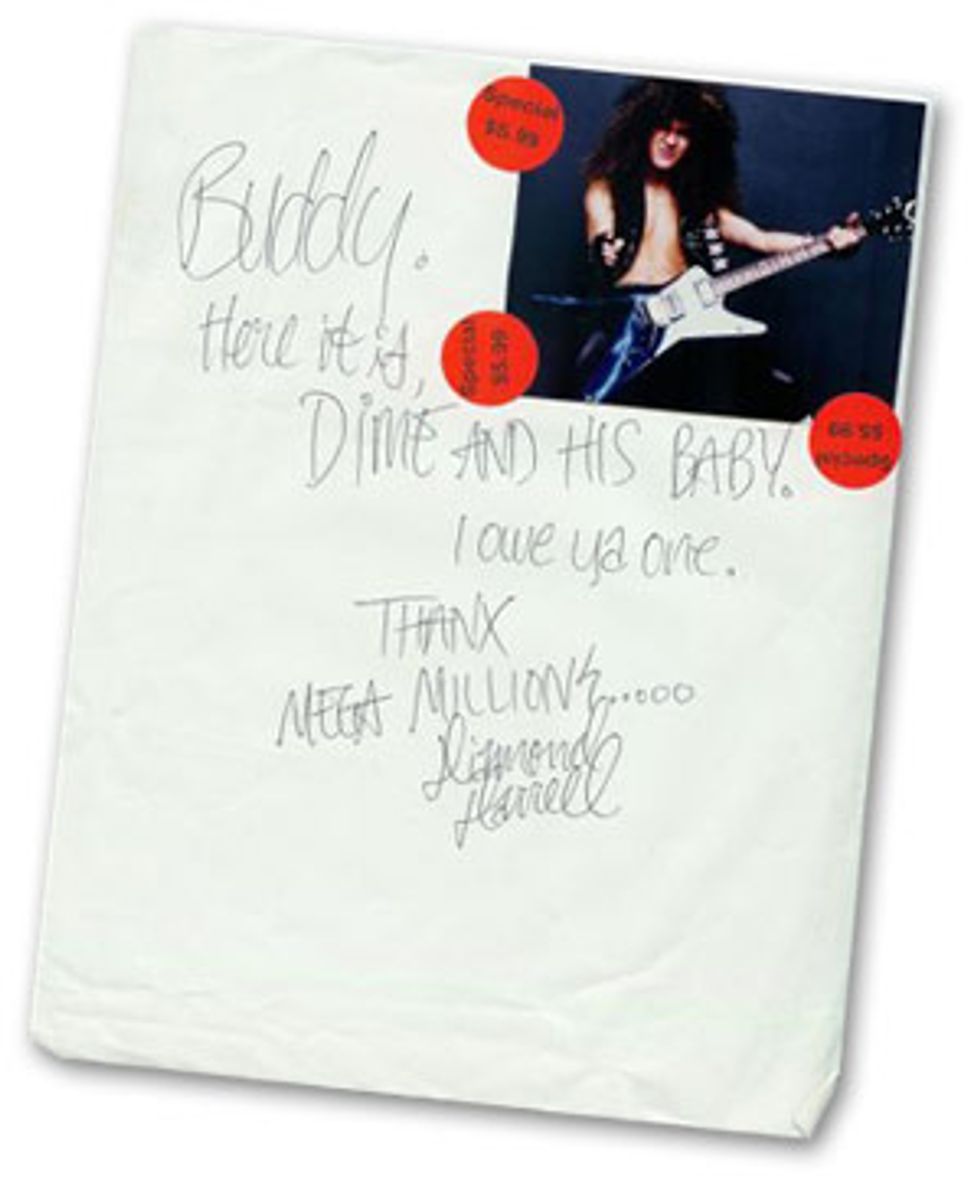 As Blaze has dealt with the tragic loss of one of his closest and oldest friends, he realizes that whenever he sees Darrell in photos or videos with that guitar, that Darrell is carrying a piece of Buddy with him.
As Blaze has dealt with the tragic loss of one of his closest and oldest friends, he realizes that whenever he sees Darrell in photos or videos with that guitar, that Darrell is carrying a piece of Buddy with him.The overwhelming irony of this story is found in its core. Although Blaze admitted that he traded, painted and extensively modified the guitar for his own playing style, it was still the perfect axe for Darrell. No matter what Blaze told himself or did to the guitar, it was and always will be Darrell’s signature guitar. The paint job was created out of Blaze’s preference, but even the lightning storm guitar better described Darrell’s personality – electric and loud.
In the end, Blaze was able to improve an already solid guitar for Darrell, and really, what else are friends for?
Watch our video slideshow of more historical Dimebag and Pantera photos:



